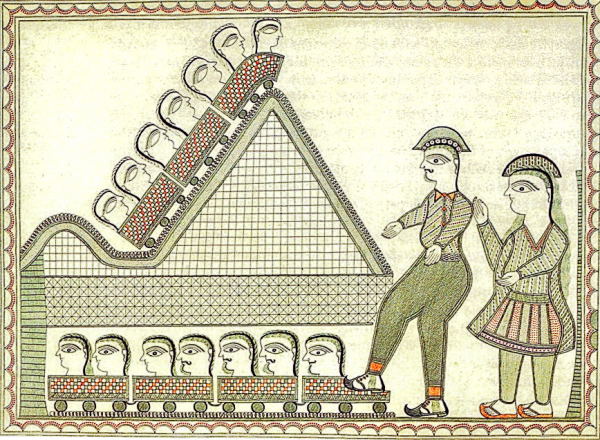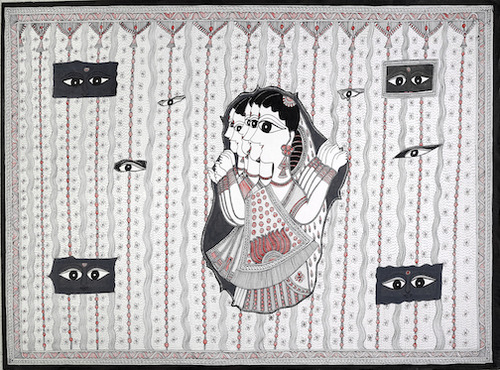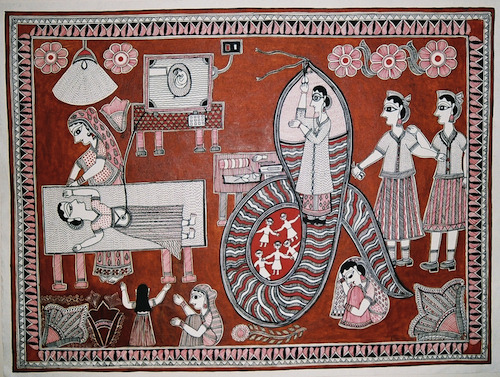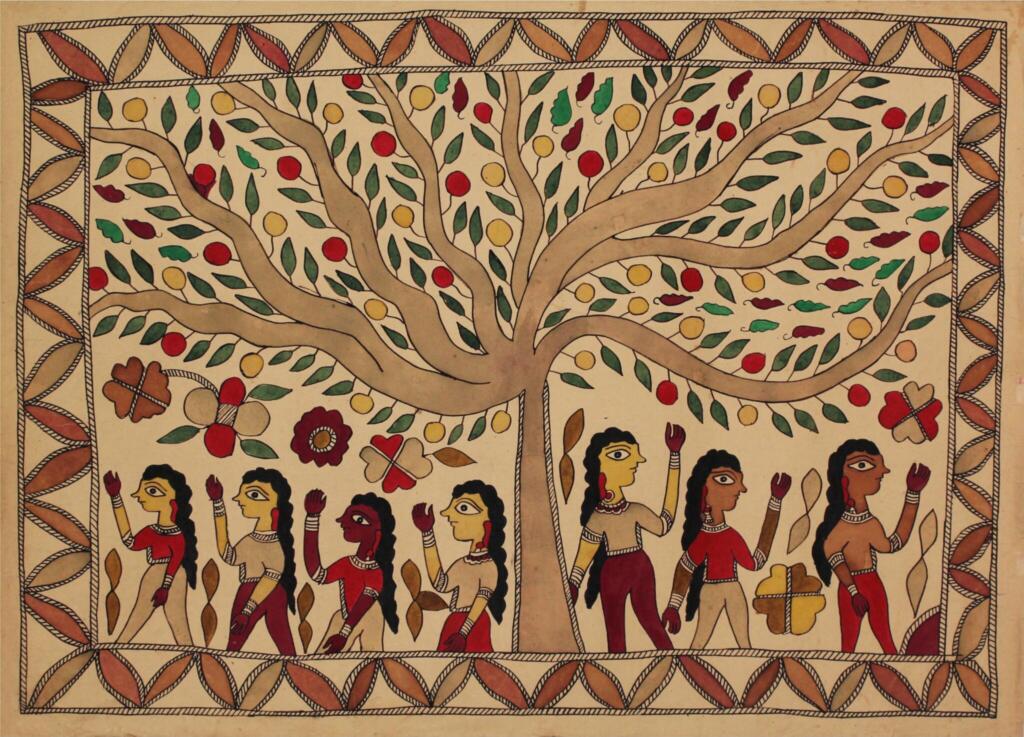
Untitled, early 21st century, unidentified artist ©️Sarmaya Arts Foundation
Historically known as Madhubani or Videha, the Mithila region of northern Bihar is a fountainhead of cultural diversity and complexities. It has been a seat of power for various kingdoms over the centuries, as well as a centre for different religious learnings: Buddhist, Jain and Hindu. From the 11th to 16th centuries in particular, the region saw an uninterrupted rule of Hindu dynasties, which led to the implementation of rigid ceremonial practices, ritualistic observations conducted strictly (and especially) in dominant-caste homes. This led to the birth of a ritual art form.
Practised solely by the women of the family, a matriarchal painting tradition thus emerged in a patriarchal society. Named after the region itself, Mithila or Madhubani painting is an umbrella term used for the art created by Dalit, Kayastha and Brahmin women, and perhaps the occasional man. The aesthetic of these paintings overlaps across castes but the symbolic language of the art form and its themes are varied.
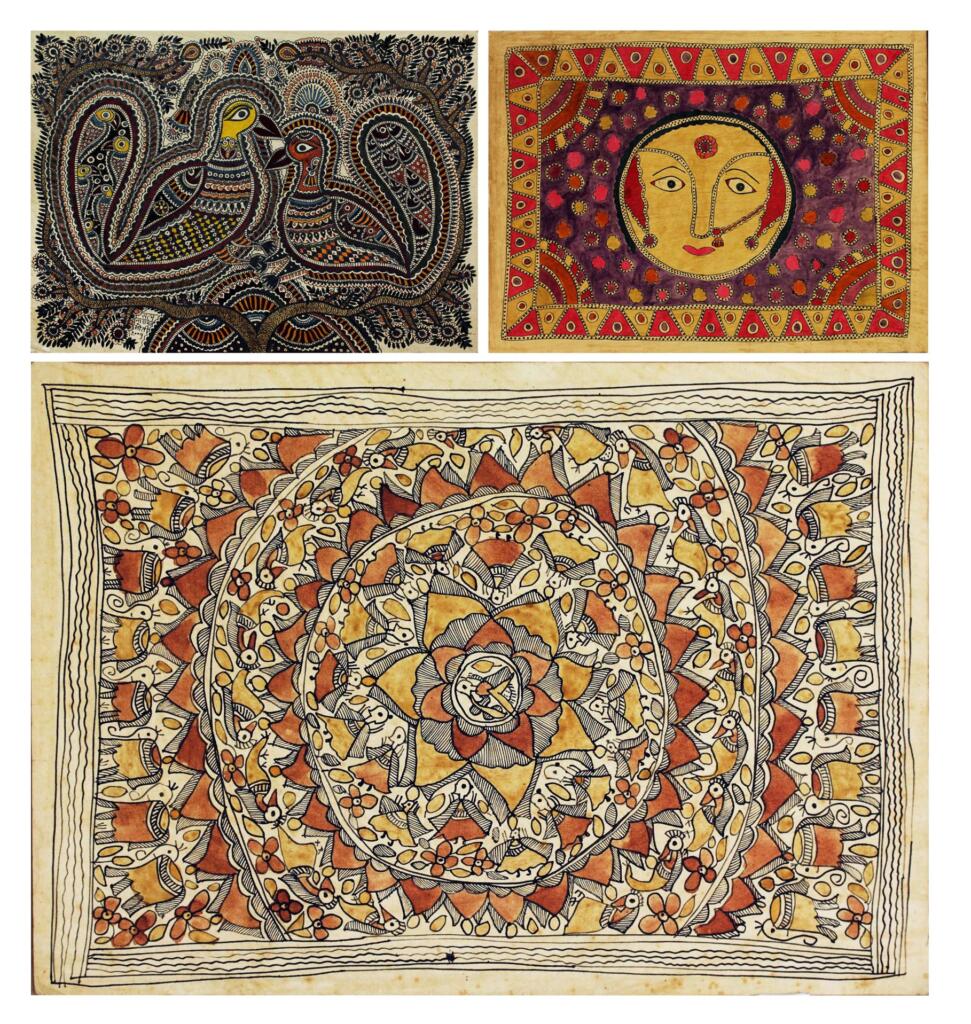
Clockwise from top left: Satyanarayan and Moti Karn (Kachani style); Untitled (Bharani style); Untitled (Godna style) all images ©️Sarmaya Arts Foundation
For Hindus, the Mithila region is held in high esteem for two reasons. One, it is recognised as the site where the left shoulder of Goddess Sati had fallen, making it an important Shaktipeeth, a pilgrimage site of the Shakti cult (currently situated in Nepal). Two, it is believed to be the birthplace of Sita from the Ramayana — the name ‘Mithila’ is derived from ‘Maithili’ which is one of her names. Almost all Hindu households in the villages are devoted to a kuldevi, an ancestral formless goddess, usually an incarnation of Goddess Kali. In Kayastha and Brahmin families, elaborate bhitti chitra (wall paintings) and aripanas (floor paintings) serve as a form of worship to these goddesses. The most important ritualistic drawings revolved around the conservative roles of women — wife and mother — and were therefore used for puberty and marriage ceremonies. Restricted strictly by purdah, the women turned the inner walls of their compounds into lavish art galleries for their own pleasure.
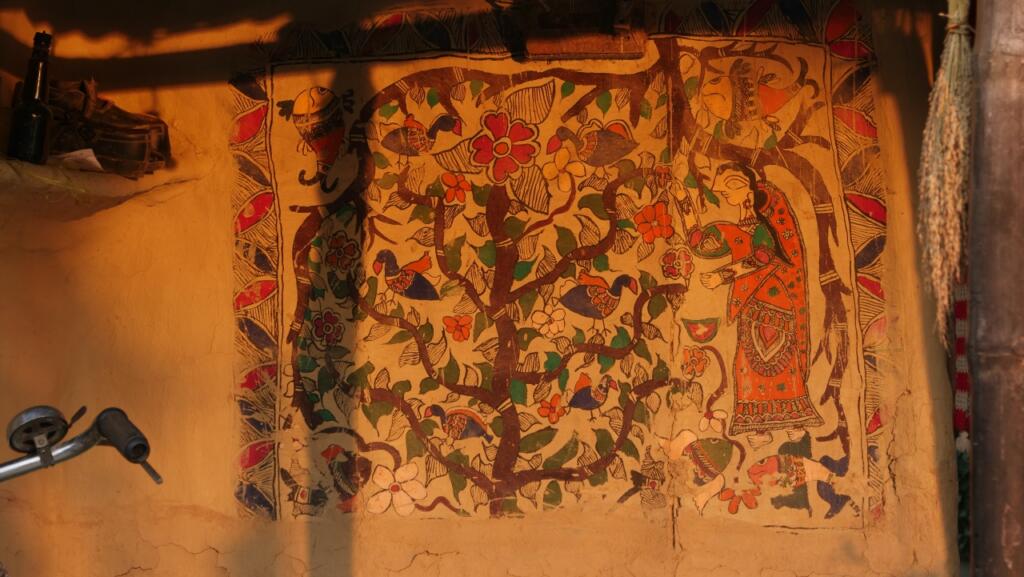
Home in Jitwarpur, image courtesy Storyloom Films
A woman’s life as a devotee would begin at the age of seven, as this is when she prays to the Goddess Gauri to be blessed with a husband who possesses the attributes of Shiva. Daily prayers and offerings are made to the goddess and on the day of her wedding, the bride bows down to the goddess, with her groom behind her, one last time to give thanks for her benevolence. She then spends the first four nights of her marriage in front of the kuldevi of her husband’s house and from then on, this becomes the principal deity she worships. This room in which the married couple spend the first four nights is the most vibrantly painted section of the house. It’s called kohbar ghar and it’s meant to be where the couple consummate their marriage. It features one of the most popular renditions of the painting’s tradition, the kohbar or puren. The word puren, used by Brahmins, literally means lotus leaf, and the drawing is a representation of lotuses or water lilies arranged in circular, geometric fashion. The lotus is symbolic of a woman’s fertility, an emblem of abundance adopted from the many local ponds carpeted with the flowers in the monsoon. The pond becomes a source for other symbols of plenty as well, like the fish (fertility), the tortoise (love) and the snake (divinity), which appear in and around the puren. The moon, sun and other idols are often drawn nearby, described as witnesses to the act of marriage.

Untitled ©️Sarmaya Arts Foundation
The Kayastha and Brahmin renditions bear slight differences. Kayastha kohbar paintings usually feature faces inside the rings of the lotuses, and a stem placed vertically piercing through the central ring of the lotus; at the top end of this stem is a face similar to that on the rings. According to artists, this object is meant to represent the stalk which tethers the lotus to the bed of the pond. The faces drawn might be representative of the goddesses, as several folktales suggest that the pond is the resting place of Goddess Gauri. The devi is depicted metaphorically in the lotus, and the lotus in turn depicts the fertility of women, creating a close association between human and divine.
The natural becomes an auspicious and feminine symbol. Several international and Indian scholars have claimed the lotuses to be a depiction of yoni, the female sex organ, and the bamboo shoot as a depiction of the phallus penetrating the yoni, thus making the kohbar a representation of the act of consummation. The original theorist was W. G. Archer, who conducted the first ever study on Mithila paintings. The theory was not sourced, in fact it was merely an interpretation by the author, yet it has been perpetuated by several art writers and publications as the original intention of the painting. I too am guilty of this repetition in my earlier writing – ‘Honeyed Vines- Floral Motifs in Madhubani Art’.
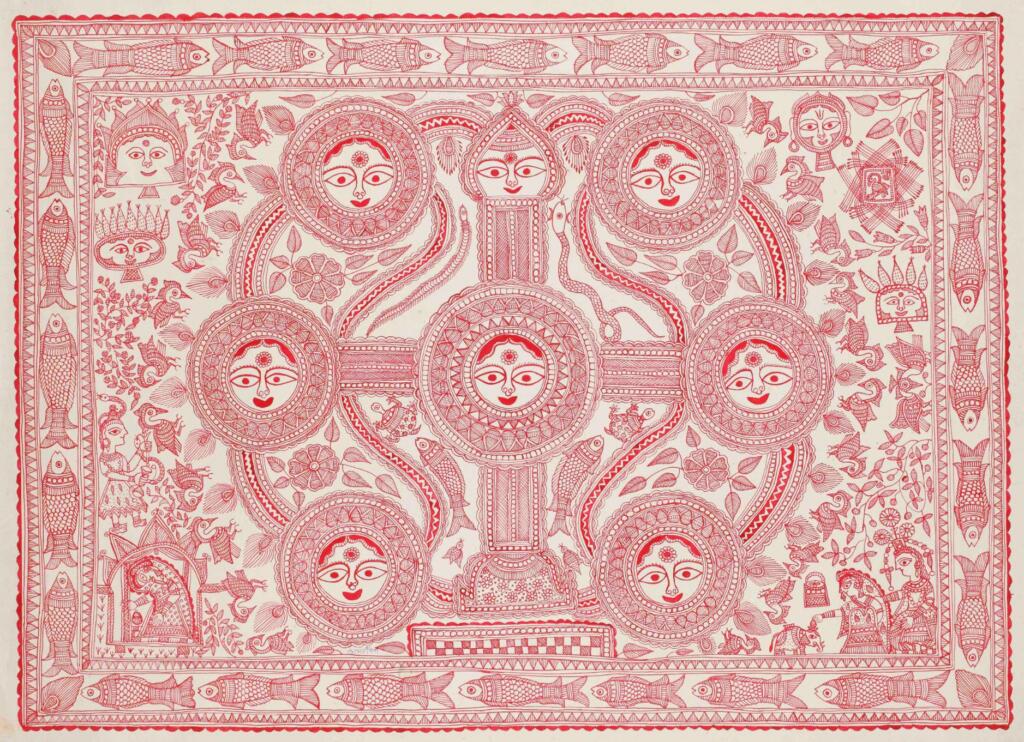
Khobar, 1991, Dulari Devi ©️Sarmaya Arts Foundation
The interpretation has circled back to the artists, several of whom have accepted the W. G. Archer’s version, as is very much in the nature of oral traditions, whose interpretations evolve with time and each significant new artist. No single explanation is the definitive one and theories abound. This is why the kohbar is also called ‘kamalban’ literally translated as ‘the lotus leaf and the bamboo stem’. The motif of bans or bamboo shoots, however, are represented in a kohbar sometimes in order to represent virility. They mostly appear on the side of the lotuses and are a sign of fast and frequent growth. The artists explain that the families wish to grow and prosper in abundance like the bamboo does — specifically with respect to the number of males in the family, as in a patriarchal society it is the men who carry on the vansh.
The ritualistic bhitti chitra has, since the 1960s, been transferred to paper and canvas so that it can be bought and sold by lovers of art everywhere. On the walls, various subjects or episodes were divided with borders of flora and fauna motifs creating a frame for each panel. In the beginning, when the canvas shifted from wall to paper, the artists were simply replicating wall art, and three types of paintings emerged in bulk: the kohbars, naina yogini and the gods and goddesses. The kohbar found a market readily because these compositions were and are unique for those of us who have limited interactions with the culture of villages like Jitwarpur, Ranti, Rahika and several others in Mithila. On paper, the kohbar started incorporating visuals from the wedding ceremony. The bride and groom would appear in the composition as they would stand in front of the Goddess Gauri, the bride sitting inside a hand-cart that is used to transport her to the groom’s house.
One such composition to appear on its own was the naina yogini, incorrectly and simplistically identified as a ‘veiled woman’ by scholars. The naina yogini is part of the Chausath yogini cult in Hinduism, and a kinswoman who is involved in the wedding ceremony of Maithili women becomes representative of the yogini. Her purpose is to protect the couple from the evil eye and cast a magic spell on the groom that binds his spirit to the bride in matrimony. Naina yoginis were drawn on all four corners of the kohbar wall, and usually depicted with a pot or basket on their head and a veiled face covering only one eye. Lastly, the compositions of deities and scenes from their epics found a space readily among Hindu buyers. In this format, some artists replicated the divided walls in miniature forms as well, often depicting incarnations of Kali, Shiva, Vishnu, Krishna et al.
Untitled (Dashavatar), 2008, Baua Devi ©️ Sarmaya Arts Foundation
Several talented artists emerged from behind the purdah that was still prevalent in the 1960s-70s. Sita Devi, Ganga Devi, Baua Devi and Shanti Devi were the first few artists whose works were nationally and internationally showcased, predominantly in the UK, USA and Japan. Gradually, these artists began painting new subjects derived from their personal experiences. Artists like Ganga Devi brought the life of a Maithil woman in front of the world with her work ‘the cycle of life’ 1983-84. This deeply personal work has a total of 24 scenes showcasing scenes from birth until adulthood in Mithila. This was perhaps the first time in the history of Mithila painting that an artist rejected the sectional form of painting and created a single flowing composition. The most striking scene in it is of a woman getting a ritual bath on attainment of puberty. The water that stains the face of the figure is beautifully depicted in a red hue charging it with overwhelming emotion. The artist went on to contemporise her paintings further by depicting classical American scenes from her visit to the country.
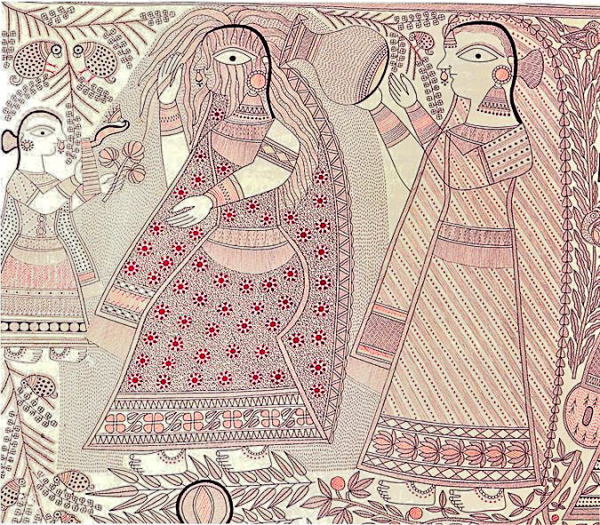
The cycle of life menstruation ritual scene, 1983, Ganga Devi, image courtesy India Tales—click for source
There is no doubt that Mithila art was traditionally an expression of feminine life; the village scenes of women winnowing grains are seen in several bhitti chitras. However, these images only represent the ‘actions’ a woman — a wife, a mother — takes part in. Contemporary artists, on the other hand, were expressing what women see and feel. With her American Series 1985 Ganga Devi depicted her individual perception of the outside world. This was in stark contrast to the tradition, which represents the collective consciousness or universal experience of Maithil women. She laid the stepping stone that several women have climbed and built upon. Overtly feminist themes have finally evolved in an art that had always been the preserve of women. Artists are now portraying powerful social commentaries against the systemic oppression of women evident in works like Abortion Clinic, 2004 and Breaking the curtain, 2011 by Rani Jha. Abortion Clinic speaks of female foeticide using traditional iconography masterfully. While the mother-in-law is seen to be pressuring her daughter to abort a female foetus, the traditionally ‘divine’ feminine serpent coils around five aborted female foetuses. The use of flowers and decorative aripana add to the satirical mood of the scene.
Works like Prakrit Purusha, 2014 and Saving the girl child, 2015 by artist Pushpa Kumari have created space in Mithila art for the female body. She uses the female form to depict not only fertility but sexuality too. In Saving the girl child the artist draws an extraordinary female figure infused with traditional symbolism of flora. The entire universe of the painting, smeared in the liquid pouring from the breasts of the mother, creates a striking visual. Pushpa Kumari’s work reinterprets the representation of the feminine in Mithila art and the reworks the visual grammar of the form itself.
The art market has benefited greatly from the voices of young, talented Mithila artists and offered them financial independence too, but the journey of ‘breaking the curtains’ has been difficult and is still incomplete. While the bhitti chitras have found mobility travelling from the inner courtyards to outer walls of houses and gradually across the world in the form of countless canvases, the mobility of the artists is still restricted, chiefly due to gender roles. One hopes that the voices of contemporary Mithila artists too proliferate, like buds of water lilies scattered across the surface of a pond, just waiting for dawn to open their faces to the sun.
References
- Traditional to Contemporary: the journey of Mithila painting by Lila Vincent Sunish, Bitasta Das and Annapurna Gariimella. 2010
- Contested meanings: Tantra and poetics of Mithila Art by Carolynn Henning Brown, 1996, American Anthropology Association
- ‘Maithil paintings’ by W. G. Archer, published in MARG: Vol 3, no 3
- Documenting the Image of Mithila Art by Carolynn Heinz Brown, 2006
- Ganga Devi: Tradition and expression in Madhubani Painting by Jyotindra ain, 2008, Mapin Publications
- ‘Mithila Paitning 1949-2014’ by David Sazton,2014 in MARG 66, No. 1

